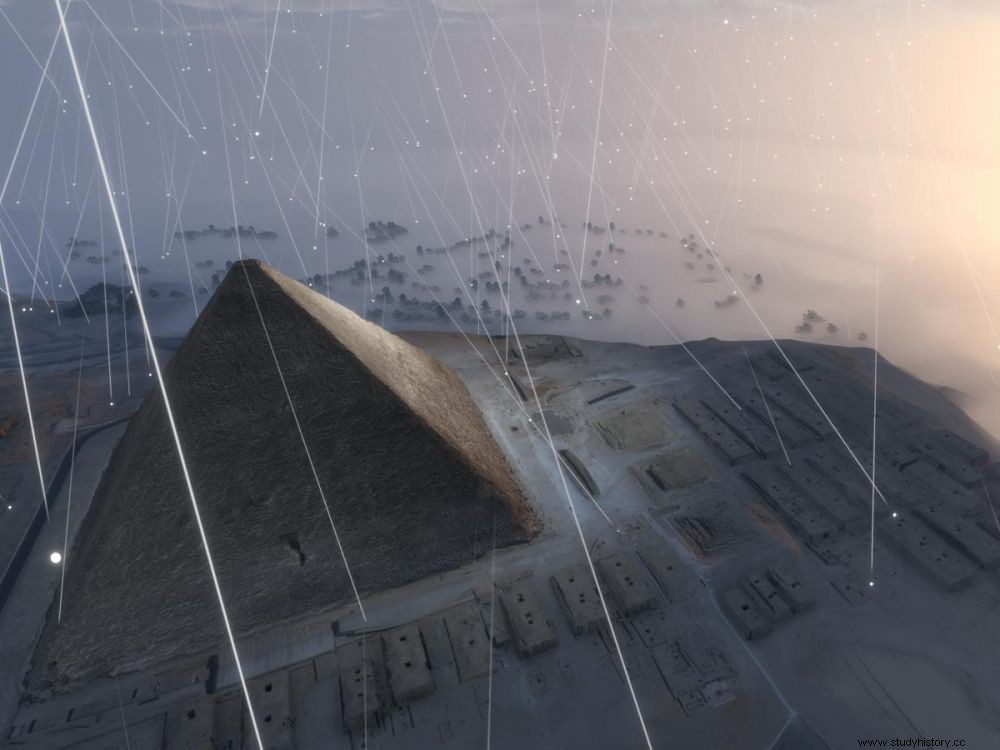The Emissive company has designed a virtual reality exhibition to explore the great pyramid of Cheops and understand how muon detectors helped locate a new secret cavity.

Muons, cosmic particles, have made it possible to explore the unfathomable.
PYRAMID. Explore the inaccessible chambers of the Great Pyramid of Cheops! A difficult dream to accomplish when you are not an Egyptologist or a field archaeologist... except perhaps through virtual reality. Because the ScanPyramids mission, which revealed on November 2, 2017 by a scientific article published in Nature the existence of a hidden cavity of 30 meters within the Cheops pyramid thanks to muon detectors, also embarked specialists in the 3D imaging for virtual reality from the company Emissive, with the support of the Dassault Systèmes Foundation. The objective:to design a virtual reality exhibition to visit the pyramid and understand how these latest discoveries were made. Science and the Future was able to live the experience in preview at the City of Architecture and Heritage in Paris.

Visiting the inaccessible, under a shower of muons
Once the virtual reality helmet (an Occulus Rift) is put on, a 40-minute immersion awaits the visitor, guided by a speaker who points out the different elements of the world reconstituted in 3D with a (virtual) laser. It also triggers the transitions and spawns the teleporters between the different areas, accessible or not to the public in the "real" Egyptian pyramid. An interior journey that allows you to visit all the known corridors of the monument, from the breakthrough of Al-Mamoun dug in the year 820 to the great gallery through the king's chamber, a vast cube of 10 meters by 5 meters overhung by several meters of granite, with its particular acoustic reverberation. At the detour, we also survey the cavity of the northeast corner and the notch allowing access to it. An overhanging point where archaeologists climbing the building could rest for a while before continuing their journey to the top.
MUONS. Along this astonishing route, we orient ourselves thanks to a three-dimensional plan of the galleries which is displayed in transparency when we observe around us, and this from new observation points, since normally taken in the mass of granite . What also visualize the detection prisms of muon telescopes that track these cosmic particles in real time, a poetic experience where we literally visualize a rain of muons. "These high-energy particles mainly fall from the sky, but are held back by matter. So that one can deduce the density of matter that a detected muon has passed through, a physical phenomenon that led to the discovery of the cavity located about 40 meters from the Queen's bedroom" , recalls Emmanuel Guerriero, co-founder of Emissive.
Textures reconstructed from more than 10,000 photographs
By participating in the ScanPyramids expeditions as a graphic partner, Emissive was able to document the 3D morphology of the interior of the pyramid by laser imaging, but also the textures of the corridors, thanks to more than 10,000 photographs."We realized that this raw material was worth gold and that we had to do something with it" , says Emmanuel Guerriero.
SCALES. The other interest of virtual reality, beyond its immersive aspect, lies in the changes of scale that it allows. "We can thus alternate aerial views where the pyramid appears as small as a model, with reconstructions faithful to scale 1. In order to facilitate scripting, we have defined teleporters which allow you to go from one Right now it's a human-led lecture-style tour, but we're looking at including a virtual guide, exploration modes reminiscent of the adventure game, or even a customization of visitor avatars" , continues the co-founder of Emissive, who recalls that this project has so far been self-financed. These virtual reality specialists are now looking for new partners to open this experience to the general public in 2018.
